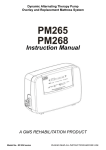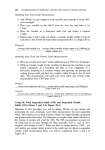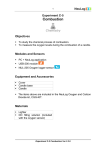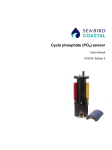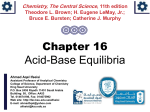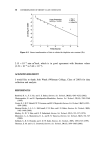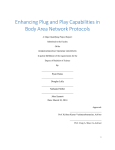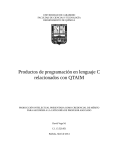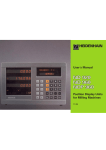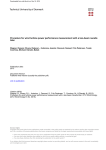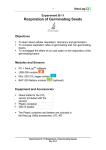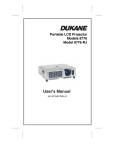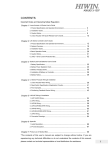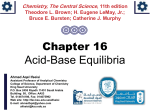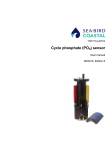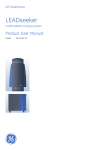Download GC Conditions 1.0-μL injection Inlet temperature ¼ 270 Column: HP
Transcript
88 CONCENTRATION OF CHLORINATED PESTICIDES IN WATER SAMPLES GC Conditions 1.0-mL injection Inlet temperature ¼ 270 C Column: HP-1 (cross-linked methyl silicone gum) 30.0 m (length) by 530 mm (diameter) by 2.65 mm (film thickness) 4.02-psi column backpressure 3.0-mL/min He flow 31-cm/s average linear velocity Oven: Hold at 180 C for 1.0 minute Ramp at 5.0 C/min Hold at 265 C for 16.0 minutes Total time ¼ 34.0 minutes Detector: Electron-capture detector Temperature ¼ 275 C Makeup gas ¼ ArCH4 Total flow ¼ 60 mL/min Retention times (from Figure 8-1) for the given GC setting are: Lindane 12.13 minutes Aldrin 16.86 minutes 2,20 ,4,40 ,6,60 -TCB 18.86 minutes Endosulfan I (IS) 19.75 minutes Dieldrin 20.95 minutes PROCEDURE 89 PROCEDURE 1. Obtain a water sample from your laboratory instructor. The water sample will be a 500- or 1000-mL glass bottle and will contain a known concentration of each analyte. 2. Set up your extraction apparatus according to Figure 8-2. Soap-wash and water-rinse all glassware that will be contacting your sample to remove interfering compounds (especially phthalates from plastics). Remove any water with a minimal amount of pesticide-grade methanol or acetone. Finally, rinse the glassware with pesticide-grade methylene chloride. Deposite rinse solvents in an organic waste bottle, not down the sink drain. 3. Fill the drying column with anhydrous Na2SO4 (a 3- to 4-inch column of Na2SO4 will be sufficient). 4. Pour the contents of your sample container into your separatory funnel. Add about 25 mL of methylene chloride to your original sample container, cap it, and shake for 30 seconds. (The purpose of this step is to remove any analyte that may have sorbed to the surface of your sample container.) 5. Quantitatively transfer the methylene chloride from your sample container to the separatory funnel. Add about 1 g of NaCl to your water sample in the separatory funnel (this will inhibit the formation of an emulsion layer that could form between the two liquid layers and interfere with your transfer to the drying column). Seal the funnel, shake vigorously for 2 minutes, releasing the pressure as necessary, and allow the layers to separate. Swirl the funnel as needed to enhance the separation and remove methylene chloride from the separatory funnel walls. Figure 8-2. Extraction setup held in place with a ring stand. 90 CONCENTRATION OF CHLORINATED PESTICIDES IN WATER SAMPLES 6. Carefully open the stopcock and allow only the bottom layer (methylene chloride) to enter the drying column. Be careful not to let any water phase enter the drying column since excessive amounts of water will clog this column. The methylene chloride should pass uninhibited into the 100.0-mL volumetric flask. 7. Add about 25 mL of methylene chloride to your sample container and repeat steps 4 through 6 two more times, collecting each extract into the 100.0-mL volumetric flask. (As you add methylene chloride to the drying column, you may occasionally need to break up the surface of the column. Water contained in the methylene chloride will be removed from the organic layer and bound to the Na2SO4, forming a crust on the surface.) 8. Rinse the drying column with additional methylene chloride and fill your 100-mL volumetric flask to the mark. 9. The concentration in your water sample and methylene chloride extract is very low and needs to be concentrated to measure the concentration adequately. We will concentrate your extract using a warm water bath and a gentle flow of N2 (or He). Pipet 10.00 mL of your 100.0-mL extract into a graduated 10- or 15-mL thimble. We will check the recovery of this step using an internal standard, Dieldrin. Using a microsyringe, add exactly 2.00 mL of an 80.0-ppm Dieldrin solution supplied by your laboratory instructor. Place the thimble in a warm water bath and adjust a gentle stream of nitrogen or helium over the surface of the liquid. The gas stream will evaporate the liquid. 10. After the liquid level has reached 1 mL, pipet 5.00 mL more of your extract into the thimble (this will give you a total of 15.0 mL). Gently evaporate the liquid to dryness, remove immediately, and add isooctane and your GC internal standard. First, pipet 2.00 mL of isooctane into the thimble. The GC internal standard is Endosulfan I. Using another microsyringe, add 2.00 mL of an 80.0-ppm solution. Using a clean Pasteur pipet, rinse the walls of the thimble from top to bottom several times. This will redissolve any analyte or internal standards that precipitated on the walls of your thimble. The final concentration of each internal standard is 32.0 ppb. 11. Transfer the isooctane extract to a GC autoinjection vial or cap your thimble until you analyze it on the GC. 12. Sign into the GC logbook and analyze your samples using the conditions given under ‘‘GC Conditions’’ in the section ‘‘In the Laboratory.’’ When you finish, record any instrument problems in the logbook and sign out. Waste Disposal All organic liquids should be disposed of in an organic hazardous waste receptacle. These solutions will be disposed of properly by the safety officer. ASSIGNMENT 91 ASSIGNMENT After you analyze your samples, calculate the concentration of each analyte in your original water sample. Calculate a standard deviation using data acquired by the entire class. Using the Student t-test spreadsheet (see Chapter 2) and the known value provided by your instructor, determine if bias is present in your analysis. 92 CONCENTRATION OF CHLORINATED PESTICIDES IN WATER SAMPLES ADVANCED STUDY ASSIGNMENT A water sample is extracted for DDT and analyzed by GC–ECD. A 500-mL water sample is extracted three times using a separatory funnel and the extract is combined to a final volume of 100.0 mL. A 20.00-mL aliquot of the 100.0 mL is concentrated to 1.00 mL. Dieldrin is added as a recovery check standard to the 1.00-mL concentrated extract at a concentration of 50.0 ppb. A GC internal standard is added to correct for injection errors and is recovered at 95.0%. Calculate the concentration of DDT in your original water sample using the following data: GC results for DDT: 45.6 mg/L in the 1.00-mL concentrated solution GC results for Dieldrin: 48.5 mg/L 9 DETERMINATION OF CHLORIDE, BROMIDE, AND FLUORIDE IN WATER SAMPLES Purpose: To learn to use ion-specific electrodes To determine the concentration simple anions in water samples BACKGROUND As rainwater falls on the Earth and contacts soil, it dissolves minerals, which are washed into streams and lakes. These waters, in turn, transport a variety of cations and anions to the oceans. Over millions of years, this resulted in the high salt content of ocean water. Common cations include sodium, potassium, calcium, and magnesium; common anions are chloride, sulfate, carbonate, bicarbonate, and nitrate, although other cations and anions may be present, depending on the local geologic media. Some ions are nutrients; others may be potentially toxic. In this laboratory we use a relatively simple method for measuring the activity of anions in water. Note that electrodes measure activity, not concentration. In low–ionic strength waters, the activity is essentially equal to concentration, but for higher ionic strengths, important differences in these measurements are present. THEORY Ion-specific electrodes are a convenient and easy way to determine the concentration of certain ions in solution. A variety of electrode designs are available, Environmental Laboratory Exercises for Instrumental Analysis and Environmental Chemistry By Frank M. Dunnivant ISBN 0-471-48856-9 Copyright # 2004 John Wiley & Sons, Inc. 93 94 DETERMINATION OF CHLORIDE, BROMIDE, AND FLUORIDE IN WATER SAMPLES including (1) liquid membrane electrodes that measure Ca2þ, BF4, NO3, ClO4, Kþ, Ca2þ, and Mg2þ (water hardness); (2) gas-sensing probes that measure NH3, CO2, HCN, HF, H2S, SO2, and NO2; and (3) crystalline membrane electrodes (solid-state electrodes) that measure Br, Cd2þ, Cl, Cu2þ, F, I, Pb2þ, Ag/S2, and SCN. We use the latter, solid-state electrodes to measure Cl, Br, and F ion concentrations. The operation of solid-state electrodes is similar to that of the glass, pH electrode. A potential is established across a membrane. In a pH electrode, the membrane is a semipermeable glass interface between the solution and the inside of the electrode, while in solid-state electrodes, the membrane is a 1- to 2-mm-thick crystal. For example, for the fluoride electrode, the crystal is composed of lanthanum fluoride (LaF3) doped with europium fluoride (EuF2). At the two interfaces of the membrane, ionization occurs and a charge is created described by LaF3 ðsÞ $ LaFþ 2 ðsÞ þ F ðaqÞ The magnitude of this charge is dependent on the fluoride ion concentration in the test sample or standard. A positive charge is present on the side of the membrane that is in contact with the lower fluoride ion concentration, while the other side of the membrane has a negative charge. The difference in charge across the membrane allows a measure of the difference in fluoride concentration between the two solutions (inside the electrode and in the test solution). The solid-state electrodes are governed by a form of the Nernst equation, E¼Kþ 0:0592 pX n ð9-1Þ where E is the voltage reading, K an empirical constant (the y intercept of the logactivity or concentration plot), 0.0592/n the slope of the line [0:0592 ¼ RT=F ðR ¼ 8:316 J/molK, T in temperature in kelvin, and F ¼ 96487 C/mol)], and pX is the negative log of the molar ion concentration. Note that for monovalent ions (an n value of 1), the slope should be equal to 0.0592 if the electrode is working properly. If a significantly different slope is obtained, the internal and external filling solutions of the reference electrode should be changed, or the end of the solid-state electrode should be cleaned. You should note that the semipermeable membrane provides only one-half of the necessary system, and a reference electrode is needed. There are three basic types of reference electrodes: the standard hydrogen electrode, the calomel electrode, and the Ag/AgCl electrode. Most chemists today use the Ag/AgCl reference electrode. This addition gives us a complete electrochemical cell. Note that a plot of the log of ion activity versus the millivolt response must be plotted to obtain a linear data plot. Also note that the concentration can be plotted as log(molar activity) or log(mg/L). REFERENCES 95 REFERENCES Skoog, D. A, F. J. Holler, and T. A. Nieman, Principles of Instrumental Analysis, Saunders College Publishing/Harbrace College Publishers, Philadelphia, 1998. Willard, H. H., L. L. Merritt, Jr., J. A. Dean, and F. A. Settle, Jr., Instrumental Methods of Analysis, Wadsworth, Belmont, CA, 1988. 96 DETERMINATION OF CHLORIDE, BROMIDE, AND FLUORIDE IN WATER SAMPLES IN THE LABORATORY Safety Precautions Safety glasses should be worn at all times during the laboratory exercise. The chemicals used in this laboratory exercise are not hazardous, but as in any laboratory, you should use caution. Chemicals Sodium or potassium salts of chloride, bromide, or fluoride (depending on the ion you will be analyzing) Ionic strength adjustor (consult the user’s manual) Equipment and Glassware Solid-state electrodes (each ion will have a specific electrode) Ag/AgCl reference electrode mV meter Standard volumetric flasks Standard beakers and pipets PROCEDURE 97 PROCEDURE The exact procedure will depend on the brand of electrode you are using. Consult the user’s manual. In general, you will need an ionic strength adjustor that does not contain your ion of interest, a single- or double-junction reference electrode (specified in the solid-state electrode user’s manual), and a set of reference standards made from the sodium or potassium salts. In general, the range of standards should be from 0.50 to 100 mg/L. 1. First, set up your electrodes and allow them to equilibrate in the solution for the time specified in the user’s manual. 2. Make up your reference standards and analyze them from low to high concentration. 3. Make a plot according to equation (9-1) (mV versus the negative log of your analyte concentration) and ensure that the slope is at or near 59.2. 4. Analyze your unknown samples. 5. Calculate the concentration in your samples. 6. Disassemble the setup. Dry off the solid-state electrode and return it to its box. Empty the filling solution of the reference electrode, wash the outside and inside with deionized water, and allow it to air dry. Waste Disposal All solutions can be disposed of down the drain with excess water. 98 DETERMINATION OF CHLORIDE, BROMIDE, AND FLUORIDE IN WATER SAMPLES ASSIGNMENT Use the Excel spreadsheet to analyze your data. Calculate the concentration of analytes in your samples. ADVANCED STUDY ASSIGNMENT 99 ADVANCED STUDY ASSIGNMENT Research solid-state electrodes. Draw a complete electrode setup, including a cross section of a solid-state electrode and a cross section of an Ag/AgCl reference electrode. DATA COLLECTION SHEET 10 ANALYSIS OF NICKEL SOLUTIONS BY ULTRAVIOLET–VISIBLE SPECTROMETRY SAMANTHA SAALFIELD Purpose: To determine the concentration of a transition metal in a clean aqueous solution To gain familiarity with the operation and applications of an ultraviolet–visible spectrometer BACKGROUND When electromagnetic radiation is shown through a chemical solution or liquid analyte, the analyte absorbs specific wavelengths, corresponding to the energy transitions experienced by the analyte’s atomic or molecular valence electrons. Ultraviolet–visible (UV–Vis) spectroscopy, which measures the absorbent behavior of liquid analytes, has in the last 35 years become an important method for studying the composition of solutions in many chemical, biological, and clinical contexts (Knowles and Burges, 1984). UV–Vis spectrometers operate by passing selected wavelengths of light through a sample. The wavelengths selected are taken from a beam of white light that has been separated by a diffraction grating. Detectors (photomultiplier tubes or diode arrays) report the amount of radiation (at each wavelength) transmitted through the sample. The peaks and troughs of absorption at different wavelengths for a particular analyte are characteristic of the chemicals present, and the concentration of chemicals in the sample determines the amount of Environmental Laboratory Exercises for Instrumental Analysis and Environmental Chemistry By Frank M. Dunnivant ISBN 0-471-48856-9 Copyright # 2004 John Wiley & Sons, Inc. 101 102 ANALYSIS BY ULTRAVIOLET–VISIBLE SPECTROMETRY radiation reaching the detector. Thus, for a given solution, the wavelength of maximum absorption (lmax) remains constant, while the percent transmittance increases and the absorbance decreases as the solution is diluted (as will be seen in this experiment). Major limitations of UV–Vis spectroscopy result from the nonspecific nature of the instrument. Spectrometers simply record how much radiation is absorbed, without indicating which chemical species is (are) responsible. Thus, spectroscopy is most valuable in analyzing clean solutions of a single known species (often at different concentrations, as studied in this experiment), or analytes such as plating solutions, which have only one (metal) species that will absorb visible light. Procedures for activating a particular species, or giving it color through chemical reaction, can also make spectroscopy useful for analyzing complex matrices. UV–Vis spectroscopy has various applications in environmental chemistry. For plating solutions, knowing the amount of metal present in waste determines treatment procedures. Complex extraction and digestion procedures are also used to determine the concentrations of species, from iron to phosphate, in soils, sediments, and other environmental media. THEORY The relationship between absorbance and concentration for a solution is expressed by Beer’s law: A ¼ ebc ¼ log T ð10-1Þ where A is the absorbance by an absorbing species, e the molar absorptivity of the solution, independent of concentration (L/molcm), b the path length of radiation through cell containing solution (cm), and c the concentration of the absorbing species (mol/L). Thus, when the molar absorptivity (dependent on the atomic or molecular structure) and path length are held constant, the absorbance by an analyte should be directly proportional to the concentration of the absorbing species in the analyte. This leads to a linear relationship between concentration and absorbance and allows the concentration for unknown samples to be calculated based on plots of data for standards of known concentrations. If more than one absorbing species is present, the absorbance should be the sum of the absorbances of each species, assuming that there is no interaction between species. Beer’s law generally holds true for dilute solutions (where absorbance is less than 3). At higher concentrations, around the limit of quantitation, the plot of concentration versus absorbance levels out. This occurs as the absorbing species interferes with itself so that it can no longer absorb at a rate proportional to its concentration. A leveling out of the Beer’s law plot may also be observed at very low concentrations, approaching the limit of linearity and the detection limit of the instrument. THEORY 103 The absorbance of electromagnetic radiation by chemical compounds in solution results from the transitions experienced by the compounds’ electrons in response to the input of photons of distinct wavelengths. Organic compounds often contain complex systems of bonding and nonbonding electrons, most of which absorb in the vacuum–UV range (less than 185 nm). Functional groups that allow excitation by, and absorbance of, radiation in the longer UV or visible wavelengths are called chromophores. For example, unsaturated functional groups, containing nonbonding ðnÞ or pi-orbital (p) electrons, absorb between 200 and 700 nm (often in the visible range) as they are excited into the antibonding pi orbital ðp Þ. The absorption of visible radiation by light transition metals leads to primary applications of spectroscopy to inorganic compounds. These metals have a characteristic set of five partially filled d orbitals, which have slightly different energies when the metals are complexed in solution. This enables electronic transitions from d orbitals of lower to higher energies. In solutions of divalent metals with nitrate, such as the solution of Ni(NO3)2 6H2O that we study in this experiment, six water molecules generally surround the dissolved metal in an octahedral pattern (Figure 10-1). The negative ends of these molecules, aligned toward the unfilled d orbitals of the metal, repel the orbitals and thus increase their energy. However, due to the distinct orientations of the various d orbitals around the nucleus, some are more affected than others by this repulsion. The relatively small resulting energy differences correspond to photons in the visible range. For lightweight transition metals, these wavelengths vary according to the solvent (in this experiment, water) and resulting ligand (Ni(H2O)62; in contrast, the spectra for lanthanide and actinide metals have sharper peaks and are generally independent of solvent. Overall, the subtle d-orbital splitting in transition metal solutions gives these solutions their colors and makes them valuable candidates for visible spectrometric analysis. Although all spectrophotometers operate on the same principles, they have a number of variations that affect their operation and analytical flexibility. Some instruments have adjustable bandwidths, which allow you to change the amount of Figure 10-1. Model of octahedral nickel ion–water complex. 104 ANALYSIS BY ULTRAVIOLET–VISIBLE SPECTROMETRY the diffracted light that the instrument allows through to the sample. Narrow slit widths allow a finer resolution, while widening the bandwidth gives a stronger signal. One consideration regarding both bandwidths and analyte concentrations is the signal-to-noise ratio of the results. Like all instruments, spectrophotometers have some background signal, a ‘‘noise’’ that is manifested as the standard deviation of numerous replicate measurements. With either narrow slit widths or lower concentrations, the signal-to-noise ratio (average reading/standard deviation) may increase due to a decrease in the signal, although this is more significant in regard to concentrations. Spectrophotometers may also be single- or double-beam, the primary difference being the continual presence of a blank cell in the double beam, eliminating the need for repeated reference measurements, since during each measurement the beam of radiation passing through the analyte cell also passes through the reference cell on its way to the detector. Also, whereas in older, nonautomated spectrophotometers it was preferable to take measurements of percent transmittance because they gave a linear plot, on newer digital machines it is fine to read absorbance directly. REFERENCES Knowles, A. and C. Burges (eds.), Practical Absorption Spectrometry, Vol. 3, Chapman & Hall, London, 1984. Sawyer, D. T., W. R. Heineman, and J. M. Beebe, Chemistry Experiments for Instrumental Methods, Wiley, New York, 1984. Skoog, D. A., J. F. Holler, and T. A. Nieman, Principles of Instrumental Analysis, 5th ed., Harcourt Brace College Publishing, Philadelphia, 1998. IN THE LABORATORY 105 IN THE LABORATORY Chemicals ACS-grade crystalline Ni(NO3)2 6H2O Equipment and Glassware Spectrophotometer (automated is preferable, but a Spectronics 20 will work), with visible radiation lamps Analytical balance Five 25-ml volumetric flasks per student or pair of students 1-mL, 2-mL, 4-mL, and 10-mL pipets Matched cuvettes for visible light Preparation of Standards 0.250 M Ni(NO3)2 6H2O: Dissolve about 1.82 g of crystalline Ni(NO3)2 6H2O in deionized water in a 25-mL volumetric flask. Record the actual weight of Ni(NO3)2 6H2O added, to calculate the actual concentration. Dilutions: 0.0100 M, 0.0200 M, 0.0400 M, and 0.100 M Ni(NO3)2 6H2O: Pipet 1.00 mL, 2.00 mL, 4.00 mL, and 10.00 mL of 0.250 M Ni(NO3)2 6H2O, respectively, into 25-mL volumetric flasks. These and the remaining 0.250 M solution can be stored in covered beakers if necessary or to make them easier to transfer. 106 ANALYSIS BY ULTRAVIOLET–VISIBLE SPECTROMETRY PROCEDURE 1. Turn on the spectrophotometer and allow it to warm up for 20 minutes. 2. If the spectrophotometer is connected to a computer, turn the computer on and open the appropriate program. 3. Use the 0.100 M Ni(NO3)2 6H2O solution to test for maximum absorbance (lmax). Rinse the cuvette with deionized water, followed by a small portion of the analyte solution, and then pour about 3 mL of solution into a cuvette. Zero the spectrophotometer. If your instrument will scan across a range of wavelengths, perform a scan from 350 to 700 nm. If not, you need to test the absorbance of the solution every 5 nm across this range. Record the location of the largest, sharpest peak. Retain the cuvette with 0.100 M nickel for use in step 5. 4. If working on a computer, open the fixed-wavelength function. Set the wavelength to the lmax you found in step 3 on either the computer or the manual dial. If bandwidth is adjustable, set it at 2 nm. Rezero the instrument. 5. Analyze the 0.100 M nickel solution already in the cuvette at lmax. Repeat 5 to 10 times, and record the absorbance readings. Empty the cuvette, rinse it with deionized water and with the 0.0100 M solution, fill it with the 0.0100 M solution, and analyze the contents 5 to 10 times. Repeat this process for each of the remaining three solution concentrations, proceeding from least to most concentrated. 6. Obtain an unknown in a 25-mL volumetric. Determine it absorbance at lmax, taking five measurements. Note on blank measurements: If you are using an automatic spectrophotometer, you only need to take blank measurements at the beginning and end of the day. If you are on a manual instrument, take blank measurements often, such as when you change solutions or parameters of measurements. Optional Procedures Signal-to-Noise Ratio 1. Analyze three or more of the nickel concentrations at least 20 times, recording each absorbance, and calculate the mean and standard deviation about the mean of the repetitive measurements. (signal-to-noise ratio ¼ mean/standard deviation). 2. Compare the signal-to-noise ratios for the various concentrations. What effect does changing concentration have on the ratio? What implication does that have for the quality of results? PROCEDURE 107 Wavelength and Signal-to-Noise Ratio 1. Analyze one or more of the nickel concentrations at more than one wavelength (lmax and at least one at nonpeak absorbance) with at least 20 repetitions for each wavelength. Be sure to rezero the instrument each time you change the wavelength. 2. Compare the absorbance at various wavelengths. Does the trend make sense? Compare the signal-to-noise ratios for the same concentration at different wavelengths. What effect does changing wavelength have on the ratio? What implication does that have for the quality of results? Slit Width and Signal-to-Noise Ratio. This requires an instrument with adjustable bandwidths. 1. Analyze two or more of the nickel concentrations at multiple bandwidths (e.g., 0.5 nm, 2 nm, 10 nm), with at least 20 repetitions for each bandwidth. Be sure to rezero the instrument each time you change the bandwidth. 2. Compare the absorbances and the signal-to-noise ratios for various bandwidths. Note: To conserve solutions in carrying out these optional procedures, work with one solution at a time by incorporating these procedures into step 5 of the main procedure. [The frequent changing of settings (precedents) that this requires may make it difficult on a Spectronics 20 (nonautomated) system.] For example, if you plan to complete all the procedures, when you get to step 5, scan the 0.100 M solution 20 times (at l ¼ lmax and bandwidth ¼ 2 nm). Then change the wavelength and scan 20 times again. Return the wavelength to lmax, change the bandwidth, and scan at 0.5 nm and then at 10 nm. Restore the original settings and proceed to the other solutions, carrying out as many of the optional procedures as desired. The most important thing to remember is to rezero the instrument each time you change the wavelength or bandwidth. Waste Disposal Nickel solutions should be placed in a metal waste container for appropriate disposal. 108 ANALYSIS BY ULTRAVIOLET–VISIBLE SPECTROMETRY ASSIGNMENT 1. Create a Beer’s law plot similar to the one shown in Figure 10-2, relating nickel concentration (x axis) to mean absorbance ( y axis) for the standard solutions. Be sure to use the actual concentrations of the solutions you made if they varied from the stated value. Turn in a copy of this plot along with a short table of the corresponding data (mean absorbances and concentrations). 2. Complete a linear least squares analysis on the Beer’s law plot, using the statistical template spreadsheet provided on the included CD-ROM or from your instructor. Turn in a copy of the spreadsheet with a short discussion of what the analysis indicates about your data. 3. Evaluate your unknowns. After you have entered the data for the standards into the ‘‘LLS’’ spreadsheet, enter the absorbances (‘‘signals’’) of the unknowns into the bottom of the sheet. Transfer the concentrations calculated by Excel for these absorbances into the ‘‘t-test’’ sheet (‘‘observation’’ column). Enter the number of replicates (N), and set the desired degrees of freedom (usually, N 1) and the confidence interval. Fill in the true unknown concentrations provided by your instructor, and consult the statistical test to see whether bias is present in your measurements. Include a copy of the spreadsheets in your lab manual with a short discussion of what this test indicates and of possible sources of discrepancy between your calculated concentration values and the true values. 1.4 y = 4.53236x + 0.05786 R2 = 0.994 Absorbance 1.2 1 0.8 0.6 0.4 0.2 0 0.0000 0.0500 0.1000 0.1500 0.2000 0.2500 0.3000 Concentration (M) Figure 10-2. Example of typical student data: Beer’s law plot for Ni(NO3)2 6H2O. ADVANCED STUDY ASSIGNMENT 109 ADVANCED STUDY ASSIGNMENT Hand-draw a spectrophotometer. Label the components and explain briefly operation of the instrument. DATA COLLECTION SHEET PART 4 EXPERIMENTS FOR HAZARDOUS WASTE 11 DETERMINATION OF THE COMPOSITION OF UNLEADED GASOLINE USING GAS CHROMATOGRAPHY Purpose: To learn to use a capillary column gas chromatography system To learn to use column retention times to identify compounds To learn to calibrate a gas chromatograph and quantify the mass of each peak BACKGROUND Petroleum hydrocarbons may well be the most ubiquitous organic pollutant in the global environment. Every country uses some form of hydrocarbons as a fuel source, and accidental releases result in the spread and accumulation of these compounds in water, soil, sediments, and biota. The release of these compounds from underground storage tanks is the most common release to soil systems, and this is discussed in Chapter 16. The drilling, shipping, refining, and use of petroleum products all account for serious releases to the environment. Crude oil consists of straight-chained and branched aliphatic and aromatic hydrocarbons. Upon release into the environment, some compounds undergo oxidation. Chemical and photochemical oxidation occur in the atmosphere; in water and soil systems, microorganisms are responsible for the oxidation. The analysis of crude oil, and organic compounds in general, has improved enormously with the advent of capillary column gas chromatography. In fact, capillary Environmental Laboratory Exercises for Instrumental Analysis and Environmental Chemistry By Frank M. Dunnivant ISBN 0-471-48856-9 Copyright # 2004 John Wiley & Sons, Inc. 113 114 COMPOSITION OF UNLEADED GASOLINE USING GAS CHROMATOGRAPHY Norway Venezuela United Kingdom Iran Indonesia Canada Saudi Arabia China Russia United States 0 10 20 30 40 50 60 70 Quadrillion BTU per year Oil Natural Gas Coal Figure 11-1. Energy production of selected countries. (U.S. EPA, 2002.) column GC can even identify the country of origin of a crude oil sample based on the chemical/compound composition. One of the largest problems with respect to the release of hydrocarbons in the environment is that they are hydrophobic (they do not like to be in water). Hydrocarbons are organic compounds and do not undergo hydrogen bonding, and thus do not readily interact with water. As a result, hydrocarbons bioaccumulate in the fatty tissue of plants and animals or associate with organic matter in soils and sediments. Compounds can be toxic at low levels, one of the most common examples being benzene, present in all gasoline products. Our use of petroleum hydrocarbons is ever-increasing. Figure 11-1 summarizes the production rates for the highest-energy-consuming countries. You will note that the United States produces (and consumes) the most energy per year. But how do we use this energy? Figure 11-2 shows a breakdown of the energy use into Million barrels per day 20 72% 15 67% 10 Transportation 53% Industrial 5 Residential and commercial Electric Utility 0 1970 1980 1990 2000 2010 2020 Figure 11-2. Current and predicted energy consumption in the United States. (U.S. EPA, 2002.) THEORY 115 electric, residential and commercial, industrial, and transportation. Transportation, the largest form of consumption, is increasing at an alarming rate. This not only explains the intensive research programs in fuel cell technology but also the geopolitical conflicts in the Middle East. THEORY Although it takes months to years to become a good chromatographer, this laboratory exercise will introduce you to the basics of chromatography. There are many highly technical parts to a capillary column GC, including the ultrapure carrier and makeup gases, flow controller values, injector, column, oven, a variety of detectors, and a variety of data control systems. You should consult a textbook on instrumental methods of analysis for details on each of these systems. The basic theory important to understand for this laboratory exercise is that there is generally a separation column for every semivolatile compound in existence. We limit the GC technique to volatile or semivolatile compounds since the compound must travel through the system as a gas. Nonvolatile or heat-sensitive compounds are normally analyzed by high-performance liquid chromatography (HPLC). Compounds are separated in the GC (or HPLC) column by interacting (temporarily adsorbing) with the stationary phase (the coating on the inside wall of the column). The more interaction a compound undergoes with the stationary phase, the later the compound will elute from the column and be detected. This approach allows for the separation of both very similar and vastly different compounds. Vastly different compounds can be separated by relying on the diversity of intermolecular forces available in column coatings (hydrogen bonding, dipole interactions, induced dipole interactions, etc.). Similar compounds are separated using long columns (up to 60 m). The most important parameter we have for separating compounds in GC is the oven temperature program. If we analyze a complex mixture of compounds at a high temperature (above the boiling point of all of the compounds in the mixture), we do not get adequate separation, and the mixture of compounds will probably exit the system as a single peak. But if we take the same mixture and start the separation (GC run) at a low temperature and slowly increase the oven temperature, we will usually achieve adequate separation of most or all of the compounds. This works by gradually reaching the boiling point (or vaporization point) of each compound and allowing it to pass through the column individually. In this manner, very similar compounds can be separated and analyzed. You will be using external standard calibration for your analysis. This is the common way that standards are analyzed, in which you analyze each concentration of standard separately and create a calibration curve using peak height or peak area versus known analyte concentration. However, capillary column GC requires that you account for errors in your injections. This is accomplished by having an internal standard, in our case decane, at the same concentration in every sample and standard that you inject. By having the same concentration in every 116 COMPOSITION OF UNLEADED GASOLINE USING GAS CHROMATOGRAPHY injection, you can correct for injection losses. (The peak area for the decane sample should be the same; if it is not, modern GC systems correct for any losses.) For a good summary of the theory and use of a gas chromatography system, see the down loadable GC Tutorial (http://www.edusoln.com). Your instructor will have this available on a computer for your viewing. REFERENCE U.S. EPA, http://www.epa.org, accessed July 2003. IN THE LABORATORY 117 IN THE LABORATORY This laboratory is divided into two exercises. During the first laboratory period, you will determine the retention times of analytes in an unleaded gasoline sample. For the second laboratory period, you will measure the concentration of several components in the gasoline using external and internal standard calibration. Safety and Precautions Safety glasses should be worn at all times during the laboratory exercise. This laboratory uses chemicals that you are exposed to every time you fill your car with gasoline. But this does not reduce the toxic nature of the compounds you will be handling. Many of these are known carcinogens and should be treated with care. Use all chemicals in the fume hood and avoid inhaling their vapors. Use gloves when handling organic compounds. Chemicals and Solutions One or more unleaded gasoline samples Neat samples of m-xylene, o-xylene, benzene, ethyl benzene, isooctane, toluene, and n-heptane Equipment and Glassware Several class A volumetric flasks 10-, 50-, 100-, and 500-mL syringes for making dilutions 1-, 5-, and 10-mL pipets a column gas chromatograph equipped with a DB-1 or HP-1 capillary column (a DB-5 or HP-5 will also work, but retention times will change GC Settings Splitless for the first 2 minutes, Injector temp.: 250 C Detector temp.: 310 C Oven: Initial temp.: Hold for: Ramp: Hold for: split mode for the remainder of the run 40 C 5 minutes 10 to 200 C 20 minutes or less 118 COMPOSITION OF UNLEADED GASOLINE USING GAS CHROMATOGRAPHY PROCEDURE Week 1: Determining the Retention Times 1. Turn on the GC, adjust all settings, and allow the instrument to go through a blank temperature run to clean the system. You may also inject pure pentane for this run. 2. While the GC completes the first blank run, prepare a set of reference standards for determining the retention times on your instrument (with the temperature program given in the equipment and glassware section). You will be using decane (C-10) as your internal standard for all solutions. Absolute retention times may vary slightly between GC runs, and the internal standard will allow you to calculate relative retention times (relative to that of decane) and allow you to identify each peak in subsequent GC runs. This first set of standards does not have to be quantitative since you are only checking the retention time, not the concentration of compound in any of the mixtures. To make the standards, place 2 drops of each compound in an individual vial, and add 2 drops of decane and 5 to 10 mL of pentane to each vial. Pentane serves as a good dilution solvent for this procedure since it is very volatile and will exit the GC early to leave a clean window for your analytes to elute. 3. Analyze each solution using the same temperature program and determine the absolute retention time and the relative retention time with respect to decane. 4. Copy the chromatographs for each member in your group and place them in your laboratory manual. 5. There will be plenty of time to spare during this laboratory period, but in order to finish on time, you should keep the GC in use constantly. While you are waiting for each GC run to finish, you should make your quantitative standards for next week’s lab. If you wait until next week to make these standards, you will be leaving lab very late. These standards will contain all of your compounds in each solution, but at different concentrations. Analyte concentrations should be 2, 5, 10, 15, and 25 mg/L in pentane. Each solution must also contain the internal standard, decane (at 30 to 50 mg/L). The internal standard will allow you to identify each analyte based on relative retention time and allow you to correct for any injection errors (see the theory section). Seal the standards well and store them in the refrigerator. Week 2: Determining the Composition of Unleaded Gasoline 1. Turn on the GC, adjust all settings, and allow the instrument to go through a blank temperature run to clean the system. You may also inject pure pentane for this run. PROCEDURE 119 2. While the GC completes the first blank run, arrange a set of reference standards for determining the retention times on your instrument (with the temperature program given in the equipment and glassware section). Since you used pentane as your solvent, some may have evaporated. Allow your standards to come to room temperature and adjust the volume of pentane in each vial. It is unlikely that any of the other compounds evaporated since pentane is the most volatile compound in the mixture, so you do not have to worry about a change in the concentration of your analytes. 3. Make a pure pentane injection, followed by each standard. Run the standards from low to high concentration. Calibrate the GC or store the chromatograms and use your linear least squares spreadsheet. 4. While the standards are running, make dilutions of the pure gasoline for analysis on the GC. Prepare 100- and 250-mg/L solutions of your gasoline in pentane. You will need only a few microliters of this solution, so do not waste solvent by preparing large volumes. 5. Determine the concentration of each analyte in your samples. 6. While you are waiting for the GC runs to finish, your instructor may have some literature work for you. If not, enjoy the free time and clean the lab. Waste Disposal Dispose of all wastes in an organic solvent waste container. 120 COMPOSITION OF UNLEADED GASOLINE USING GAS CHROMATOGRAPHY ASSIGNMENT 1. Prepare a labeled chromatogram of a midrange calibration standard. 2. Summarize the concentrations of analytes in your gasoline sample and correct for the internal standard. ADVANCED STUDY ASSIGNMENT 121 ADVANCED STUDY ASSIGNMENT 1. Research the operation of a gas chromatograph in the library or on the Internet. Draw and explain each major component of a capillary column system. 2. How does temperature programming affect the elution of compounds from the GC system? DATA COLLECTION SHEET 12 PRECIPITATION OF METALS FROM HAZARDOUS WASTE ERIN FINN Purpose: To treat a diluted electroplating bath solution for copper, nickel, or chromium using a variety of methods To learn to use a flame atomic absorption spectrometer BACKGROUND Hazardous waste is defined as waste containing one of 39 chemicals specified as hazardous due to their toxic, carcinogenic, mutagenic, or teratogenic properties. The U.S. Environmental Protection Agency (EPA) estimates that 6 billion tons of hazardous waste is created in the United States each year, but only 6% of that, some 360 million tons, is regulated. The remainder is composed of unregulated military, radioactive, small generator (<220 lb per month), incinerator, and household waste. The United States is the largest gross and per capita producer of hazardous waste in the world. Electroplating and engraving operations are one source of this waste. Electroplating baths are used to deposit a thin layer of metal a few millimeters thick onto a metal substrate. These layers may be used to alter the physical properties of a metal surface, such as corrosion resistance, ductile properties, and hardness, or for decorative purposes. The quality of the deposit is affected by the temperature, current, and pH of deposition, as well as the concentration of metal in the bath. Environmental Laboratory Exercises for Instrumental Analysis and Environmental Chemistry By Frank M. Dunnivant ISBN 0-471-48856-9 Copyright # 2004 John Wiley & Sons, Inc. 123 124 PRECIPITATION OF METALS FROM HAZARDOUS WASTE The most commonly used nickel-plating bath is the Watts bath, which you will use in this experiment. Nickel and chromium plating are often used in conjunction, although the two baths are not mixed, due to the resulting decrease in the quality of the chromium deposits. As metal is deposited over time, the concentration of metal in the bath is decreased to below the optimal concentration, and the bath becomes less effective. It is at this time that the bath must be disposed of or regenerated, and it is the disposal process with which we are concerned. A common initial step in the treatment of such wastes is dilution by emptying the vat into a large pool of water. In this case, the electroplating solutions are diluted to 1 : 50 from average starting plating bath concentrations because this is the greatest dilution that can readily be achieved without having to make large excesses of solution or perform serial dilutions. Various methods of treatment exist, depending on the composition and concentration of the solution to be treated. One of the cheapest and most universal treatment methods is pH precipitation, which you will perform on nickel and copper. Precipitation by pH works on the principle that at high pH values, metals form their insoluble hydroxides; for example, Cu2þ þ 2 OH ! CuðOHÞ2 ðsÞ Ni2þ þ 2 OH ! NiðOHÞ2 ðsÞ Unfortunately, this method has a disadvantage: Each metal has a unique pH value at which its hydroxide is least soluble and therefore most effectively precipitated. Literature values are presented in Table 12-1. At pH values above this ideal pH, the solubility actually increases again as the metal coordinates to form charged hydroxide species. This makes pH precipitation of mixed metal solutions difficult. Additionally, although it can be effective, pH precipitation is not always as easy to regulate consistently as are other methods. This method is also effective in treating chromium and is therefore not used in this experiment to treat hexavalent chromium. The value presented in Table 12-1 is for chromium(III), and pH precipitation would first require reduction of the chromium and then adjustment of the pH. Another method of water treatment is the use of ferric chloride (FeCl3). This operates by a completely different mechanism known as coagulation. Coagulation is a method to improve settling rates by increasing the size and specific gravity of TABLE 12-1. Literature Values of Optimum pH for Precipitation of Metal Ions Metal Cr(III) Cu Ni Mixed metals given above a Optimum pH 7.5 8.1a 10.8 8.5 Although this is the ideal literature value, it has been found in designing this exercise that 8.6 is a more effective pH value for precipitation of copper. THEORY 125 a particle. It can be used to remove silt, clays, bacteria, minerals, and oxidized metals and other inorganics from waters. The Fe3þ in ferric chloride reacts with hydroxide in basic solution: Fe3þ þ 3 OH ! FeðOHÞ3 ðsÞ Iron(III) hydroxide forms a colloid-sized particle (0.001 to 1 mm) that complexes with water molecules and becomes negatively charged by coordination of the iron with anions, especially hydroxide, in solution. Positively charged metal ions bind multiple negatively charged colloidal particles together and create a large body that precipitates out of solution and can easily be separated via sand filtration, or if sufficient time is available, even settling. Either of these methods is effective in generating a clear supernatant layer from the coagulated solution; sand and gravel filtration are common techniques used to treat water and effluent because filtration is cheap and requires fairly low maintenance. Ferric chloride is a convenient coagulant because it is cheap, easy to use, and works well over a wide pH range. It is important that the pH be high enough to counteract the acidic nature of electroplating baths and the acidity of the iron in solution, which acts as a Lewis acid to cause water to dissociate. This treatment was not found to be effective with hexavalent chromium, however. An effective treatment of hexavalent chromium involves ferrous chloride, which accomplishes reduction and precipitation simultaneously in nearly neutral to slightly basic solutions. Note that the pH given in Table 12-1 for Cr3þ is within the neutral range required. The reduction reaction is 2þ þ 4 OH ! 3 FeðOHÞ3 ðsÞ þ CrðOHÞ3 ðsÞ 4 H2 O þ CrO2 4 þ 3 Fe A mixed iron–chromium solid in the form Fex Cr1x ðOHÞ3 is also reported to be formed, where x is 0.75 when the stoichiometric relationship described above is applied. 3þ þ 4 OH ! 4 Fe0:75 Cr0:25 ðOHÞ3 ðsÞ 4 H2 O þ CrO2 4 þ 3 Fe This treatment, in combination with ferric chloride treatment, can be used to process a solution of mixed metal waste containing copper, nickel, and chromium. Although in actual practice chromium is not often mixed with other metals due to the detrimental effect that this has on chromium bath efficiency, all of these metals could be present in a hazardous waste treatment situation. THEORY The driving mechanism behind the effectiveness of precipitation treatments is the solubility product. You may recall from general chemistry that the solubility product is defined as the product of the concentrations of the ions involved in an equilibrium, each raised to the power of its coefficient in the equilibrium equation. 126 PRECIPITATION OF METALS FROM HAZARDOUS WASTE The equilibrium referred to is that between a saturated solution of a compound and the solid form of that compound. Compounds with a low solubility product do not dissolve to any great extent in water, and may be considered insoluble. Compounds with a high solubility product, such as potassium perchlorate, dissolve readily in water. The solubility product for potassium perchlorate can be expressed as 2 kspKClO4 ¼ ½Kþ ½ClO 4 ¼ 1:05 10 The solubility product of lead(II) chloride is kspPbCl2 ¼ ½Pb2þ ½Cl 2 ¼ 1:70 105 while the solubility product of lead(II) hydroxide is kspPbðOHÞ2 ¼ ½Pb2þ ½OH 2 ¼ 1:43 1020 The difference in ksp between lead(II) chloride and lead(II) hydroxide illustrates the reason that precipitation by pH is effective at removing metals from solution. REFERENCES Brown, T. L., H. E. Lemay, B. E. Bursten, and J. R. Burfge, Chemistry: The Central Science, 8th ed., Prentice Hall, Upper Saddle River, NJ, 2000, p. 660. Guidance Manual for Electroplating and Metal Finishing Pretreatment Standards, U.S. EPA, Feb. 1984, http://www.epa.gov/npdes/pubs/owm0022.pdf, accessed Feb. 2003. Hazardous Waste, http://www.members.tripod.com/recalde/lec6.html, accessed May 2003. http://www.waterspecialists.biz/html/precipitation_by_pH_, accessed Feb. 2003. Lide, D. R. and H.P.R. Frederikse (eds.), CRC Handbook of Chemistry and Physics, CRC Press, Boca Raton, FL, 1997, pp. 8-106 to 8-109. WTA’s World Wide Water, ‘‘Coagulation,’’ http://www.geocities.com/capecanaveral/ 3000/coag.htm, accessed May 2003. IN THE LABORATORY 127 IN THE LABORATORY The overall goal of all of these treatments is to remove as much of the metal as possible. In industry your target removal level would be the maximum emission concentration allowed by a state or federal governing body. The EPA has established Pretreatment Standards for Existing Sources (PSES) of electroplating waste in the Guidance Manual for Electroplating and Metal Finishing Pretreatment Standards, based on the requirements of subchapter N of the Code of Federal Regulations, Chapter 1. These standards limit the concentration of hazardous waste components that may be present in the wastewater effluent of electroplating operations. For a facility discharging >38,000 L/day, the limits are as shown in Table 12-2. These limits were established in 1984 and are part of the National Pollutant Discharge Elimination System (NPDES) limits that regulate effluents. For facilities discharging <38,000 L/day, none of these metals are regulated. Safety Precautions Keep in mind that while the plating baths are diluted about 50-fold, they are still considered hazardous waste (notice the colors—brightly colored solutions are usually not a good sign unless they are indicators!). This means that they must not be dumped down the drain without treatment! The copper-plating bath especially is quite acidic (pH about 1.5), as you will notice when you pH-treat it. Be careful not to spill on yourself! Keep a waste beaker for all your plating bath waste. When you are finished, estimate its volume and try to treat any remaining waste. All precipitates should be collected in waste jars. Supernatants and filtrates should be clean enough to meet EPA standards by the time you are finished, and can then be dumped down the drain with excess water. Be sure that you check the pH and confirm that they meet standards by checking them first on the AAS unit. Chemicals and Solutions Each student or group will be assigned one metal to work with. The solutions required for each group are slightly different. TABLE 12-2. EPA Pretreatment Standards for Existing Sources Metal Total Cr Total Cu Total Ni Daily Maximum (mg/L) 7.0 4.5 4.1 Max. 4-Day Average (mg/L) 4.0 2.7 2.6 128 PRECIPITATION OF METALS FROM HAZARDOUS WASTE Group 1: Copper 100 mL of copper-plating bath: 1.5 g of CuSO4 5H2O 5.6 mL of concentrated H2SO4 Deionized water 25 mL of 1.3 M ferric chloride 200 mL of 2 M sodium hydroxide 1% Nitric acid for preparing samples for FAAS Glass wool A few grams of sand Group 2: Nickel 100 mL of nickel-plating bath: 22.8 g of NiSO4 6H2O 6.8 g of NiCl2 6H2O 3.7 g of H3BO3 Deionized water 25 mL of 1.3 M ferric chloride 50 mL of 2 M sodium hydroxide 1% Nitric acid for preparing samples for FAAS Glass wool A few grams of sand Group 3: Chromium 100 mL of chromium-plating bath: 0.3 g of CrO3 0.003 g of Na2SO4 Deionized water (Note: A serial dilution is required to get the correct quantity of sodium sulfate, because you cannot weigh out 3 mg accurately.) 25 mL of 1 M ferrous chloride 100 mL of 2 M sodium hydroxide 10.00 mL of nickel bath and 10.00 mL of copper bath, to be obtained from the other groups 25 mL of 1.3 M ferric chloride 1% Nitric acid for preparing samples for FAAS Glass wool A few grams of sand IN THE LABORATORY 129 Equipment and Glassware 10-, 25-, 50-, and 100-mL volumetric flasks Graduated cylinders Pipets Glass chromatography columns (20 mm or wider) with buret clamps and ring stands Beakers 50- and 125-mL Erlenmeyer flasks Long glass stir rods Scintillation vials (four per person or group) Stir plates and beans pH meter and buffer solutions FAAS with Ni, Cu, and Cr hollow cathode lamps 130 PRECIPITATION OF METALS FROM HAZARDOUS WASTE PROCEDURE Group 1: Copper You will treat your waste by pH precipitation and by ferric chloride coagulation. First, make your solutions as described above. You will want to start making the copper solution early because it takes some time to dissolve. The ferric chloride also takes a little while but dissolves within 5 minutes on a stir plate. It does, however, foam on top, preventing a good volume reading. Simply do your best to get the volume as close as possible to the desired total. Since you will be dispensing the ferric chloride solution with a graduated cylinder—it is too thick and foamy to use a pipette and could cause clogging—the error introduced in doing this is one of many. pH Precipitation. Pipet 25.00 mL of your copper bath into an Erlenmeyer flask. Adjust the pH to 8.6 using 2 M NaOH. This adjustment can be difficult, as the pH changes are very sensitive near the neutral range. You may wish to dilute your sodium hydroxide to make the changes easier to fine tune. Using 2 M NaOH, it should take about 40 to 45 mL. Since the copper solution already contains sulfuric acid, 1 or 2 drops of very dilute sulfuric acid (about 0.1 M) may be used to correct the pH if you overshoot a pH of 8.6. Cover the treated solution and allow it to settle until next week’s lab. If you desire to continue working now, wait a few minutes and it will settle, but be sure that the supernatant is clear before proceeding. Pipet off a few milliliters of supernatant, being careful not to disturb the precipitate. For FAAS analysis, mix 3.00 mL of supernatant with 3.00 mL of 1% HNO3. FeCl3 Treatment. Pipet 25.00 mL of copper solution into a flask. Add approximately 5 mL of 1.3 M FeCl3 and 45 mL of 2 M NaOH. In both cases, it is better to err on the side of adding too much rather than too little. However, if you add excess FeCl3, be sure to compensate for it with excess NaOH. It is imperative that the solution be basic for the treatment to work. You may wish to confirm this using litmus paper or universal indicator paper. You may stop here with your solution covered until the next lab period if desired, or continue working. The next step is to construct a sand column. Use a glass rod to push a small plug of glass wool to the bottom of the column. Then add about 2 cm of sand over the top. Tap and gently shake the column to allow the sand to settle and reduce air gaps. Smoothly pour your treated solution onto the column. It is helpful to try to pour just the liquid initially, so that the initial stages of filtration will proceed more quickly. Once the solid plugs the pores in the sand, filtration takes much longer; it may take a couple of hours for the supernatant to filter through completely. Collect the filtrate in a clean beaker. For FAAS analysis, pipette 3.00 mL of supernatant and 3.00 mL of 1% HNO3 into a scintillation vial. PROCEDURE 131 During the second week of lab, you will analyze your samples for copper using FAAS. You will need to begin by making calibration standards at 2, 4, 8, 20, and 40 ppm (this range may depend on the FAAS unit you use) in copper with the corresponding quantities of sulfuric acid. You will probably need to use serial dilutions. Remember to make your standards in 1% nitric acid instead of deionized water. When ready to do your analyses, warm up the instrument as instructed and create your calibration curve. Use 1% nitric acid as your blank. You will share this calibration curve with the students who are working with the mixed-chromium wastewater; they will need it to analyze their mixed waste treatment. Analyze your samples five times each. You should also try to coordinate timing so that the chromium students can analyze their treated mixed waste while the correct lamp is installed in the instrument and is warmed up. Group 2: Nickel You will treat your waste by pH precipitation and by ferric chloride coagulation. First, make your solutions as described earlier. You will want to start making the nickel solution early because it takes some time to dissolve. The ferric chloride also takes a little while but dissolves within 5 minutes on a stir plate. It does, however, foam on top, preventing getting a good volume reading. Simply do your best to get the volume as close as possible to the desired total. Since you will be dispensing the ferric chloride solution with a graduated cylinder—it is too thick and foamy to use a pipette and could cause clogging—the error introduced in doing this is one of many. pH Precipitation. Pipet 25.00 mL of your nickel bath into an Erlenmeyer flask. Adjust the pH to 10.8 using 2 M NaOH. It should take approximately 5 to 7 mL. Since the nickel solution already contains nickel(II) sulfate, 1 or 2 drops of dilute sulfuric acid (<1 M) may be used to correct the pH if you overshoot the pH value of 10.8. Cover the treated solution and allow it to settle until next week’s lab. If you desire to continue working now, wait a few minutes and it will settle, but be sure the supernatant is clear before proceeding. Then pipet off a few milliliters of supernatant, being careful not to disturb the precipitate. For FAAS analysis, mix 3.00 mL of supernatant with 3.00 mL of 1% HNO3. FeCl3 Treatment. Pipet 25.00 mL of nickel solution into a flask. Add 7 mL of 1.3 M FeCl3 and 20 mL of 2 M NaOH. In both cases it is better to err on the side of adding too much rather than too little. However, if you add excess FeCl3, be sure to compensate for it with excess NaOH. It is imperative that the solution be basic for the treatment to work. You may wish to confirm the basicity of the solution using litmus paper or universal indicator paper. You may stop here with your solution covered until the next lab period if desired, or continue working. The next step is to construct a sand column. Use a glass rod to push a small plug of glass wool to the bottom of the column. Then add about 2 cm of sand over 132 PRECIPITATION OF METALS FROM HAZARDOUS WASTE the top. Tap and gently shake the column to allow the sand to settle and reduce air gaps. Smoothly pour your treated solution onto the column. It is helpful to try to pour just the liquid initially, so that it can pass through more quickly. Once the solid blocks the pores in the sand, filtration takes much longer; it may take a couple of hours for the supernatant to finish coming through the sand. Collect the filtrate in a clean beaker. For FAAS analysis, pipet 3.00 mL of supernatant and 3.00 mL of 1% HNO3 into a scintillation vial. During the second week of lab, you will analyze your samples for nickel using FAAS. You will need to begin by making calibration standards at 2, 4, 8, 20, and 40 ppm (this range may depend on the FAAS unit you use) in total nickel, with NiSO4 and NiCl2 composing appropriate proportions of the total. These standards should contain correspondingly appropriate quantities of boric acid so that the matrix is the same for your standards as the matrix of your waste solution. You will probably need to use serial dilutions. Remember to make your standards in 1% nitric acid instead of deionized water. When ready to do your analyses, warm up the instrument as instructed and create your calibration curve. Use 1% nitric acid as your blank. You will share your calibration curve with the students who are working with the mixed chromium wastewater; they will need it to analyze their mixed waste treatment. Analyze your samples five times each. You should also try to coordinate timing so that the chromium students can analyze their treated mixed waste while the correct lamp is installed in the instrument and warmed up. Group 3: Chromium You will treat your chromium by ferrous chloride precipitation and will also treat a mixed waste that contains copper and nickel in addition to chromium. First, make your solutions as described above. The ferric chloride takes a little while to dissolve but will do so within 5 minutes on a stir plate. It does, however, foam on top, preventing getting a good volume reading. Simply do your best to get the volume as close as possible to the desired total. Since you will be dispensing the ferric chloride solution with a graduated cylinder—it is too thick and foamy to use a pipette and could cause clogging—the error introduced in doing this is one of many. FeCl2 Precipitation. Pipet 25.00 mL of chromium solution into a flask. Add 5 mL of 1 M FeCl2 and 5 mL of 2 M NaOH. In both cases it is better to err on the side of adding too much rather than too little. However, if you add excess FeCl2, be sure to compensate for it with excess NaOH. For the treatment to work, it is imperative that the solution be basic. You may wish to confirm the basicity of the solution using litmus paper or universal indicator paper. You may stop here with your solution covered until the next lab period if desired, or continue working. The next step is to construct a sand column. Use a glass rod to push a small plug of glass wool to the bottom of the column. Then add 2 cm of sand over the top. Tap and gently shake the column to settle the sand and reduce air gaps. PROCEDURE 133 Smoothly pour your treated solution onto the column. It is helpful to try to pour just the liquid initially, so that the initial stages of filtration proceed more quickly. Once the solid fills the pores in the sand, filtration takes much longer; it may take a couple of hours for all of the supernatant to come through. Collect the filtrate in a clean beaker. For FAAS analysis, pipet 3.00 mL of filtrate and 3.00 mL of 1% HNO3 into a scintillation vial. Mixed Waste Treatment. Prepare a mixed electroplating bath waste by pipetting 10.00 mL of each metal solution into a flask. You will need to get copper and nickel bath solutions from the other groups. Add 5.5 mL of 1.3 M FeCl3 and 30 mL of 2 M sodium hydroxide. Mix the solution well and allow it to sit. You may stop here or after the filtration step that follows. While it sits, construct a sand column as you did before, with glass wool and 2 cm of sand in the bottom. Pour your treated solution slowly over the top of the column. Collect the filtrate. You will notice that it is a bright yellow color. This is because the ferric chloride has succeeded in removing the nickel and copper but not the chromium. To remove the chromium, you will need to add 2.2 mL of 1 M ferrous chloride and 2.2 mL of 2 M sodium hydroxide and swirl to mix well. Once this is done, you may stop here or continue. Allow the precipitate to settle and collect a few milliliters of supernatant carefully with a pipette so as to avoid disturbing the precipitate. Mix 3.00 mL of supernatant with 3.00 mL of 1% HNO3 for FAAS analysis. During the second week of lab, you will analyze your ferrous chloride–treated sample for chromium and your mixed waste–treated sample for copper, nickel, and chromium using FAAS. For the mixed waste, it does not matter in what order you analyze for the various metals. You will need to coordinate instrument time with other students so as to be able to perform your analyses while the appropriate lamp is installed and warmed up in the instrument. You will need to begin by making calibration standards at 1.6, 4, 8, 20, and 40 ppm in chromium (this range may depend on the FAAS unit you are using). You will need to use serial dilutions. For the copper and nickel analyses, you will use the calibration curves created by your peers. Remember to make your standards in 1% nitric acid instead of deionized water. When ready to do your analyses, warm up the instrument as instructed and create your calibration curve. Use 1% nitric acid as your blank. Analyze each sample five times. You should carefully plan your data collection and recording strategy since there are several types of data to be collected and the entire class is dependent on your data. After collecting your FAAS results, you should perform a linear least squares analysis, convert absorbance signal to concentration, and then correct that concentration for the dilution you used in preparing your supernatant sample for FAAS, to determine the concentration of metal in your treated solution. Then correct for dilutions during treatment (assuming additive volumes) and calculate your percent removal. (Contrast your results for pH precipitation in light of the calculated solubility of the metals based on the final solution pH and the Ksp value of the hydroxide of that metal. Why might the two answers not agree?) 134 PRECIPITATION OF METALS FROM HAZARDOUS WASTE Questions to think about for your write-up: 1. How effective is each treatment for each metal? Do the treated solutions meet EPA standards? 2. How reproducible are the results of the treatment when the same procedure is used? 3. Which procedure is easiest to use on this scale? On an industrial scale (i.e., treating at least 100 L of effluent)? 4. Which procedure is cheapest? Which uses the least harmful chemicals? DATA COLLECTION SHEET 1 135 PRECIPITATION OF METALS FROM HAZARDOUS WASTE: DATA COLLECTION SHEET 1 Name: _____________________________ Lab partners: ________________________ Date: ______________________________ Metal assigned: ______________________ Solution Preparation Metal solution: Cu_______________ Metal solution: Ni_______________ Volume prepared: 100 mL_________ Volume prepared: 100 mL_________ Solution Component Mass or Volume Used Solution Component Metal solution: Cr_______________ Volume prepared: 100 mL_________ Solution Component Solution NaOH FeCl3 6H2O FeCl2 HNO3 Mixed metals solution Volume prepared: 30:00 mL_______ Mass or Volume Used Mass of Solid or Volume Used Mass or Volume Used Solution Component Concentration Mass or Volume Used 136 PRECIPITATION OF METALS FROM HAZARDOUS WASTE Data Collection pH Precipitation of Nickel Trial 1 Initial pH Initial Buret Vol. (mL) Final Buret Vol. (mL) 2 3 FeCl3 Coagulation of Nickel Trial 1 2 3 Vol. of FeCl3 Used (mL) Vol. of 2 M NaOH Used (mL) Vol. of 2 M NaOH Used (mL) Final pH DATA COLLECTION SHEET 2 PRECIPITATION OF METALS FROM HAZARDOUS WASTE: DATA COLLECTION SHEET 2 FeCl2 Precipitation of Cr Vol. of FeCl2 Used (mL) Trial 1 Vol. of 2 M NaOH Used (mL) 2 3 Mixed Waste Treatment Trial 1 Vol. FeCl3 (mL) Vol. NaOH (mL) 2 3 FAAS Data Element: _________________________ Wavelength: ______________________ Slit width: _______________________ Lamp current: ____________________ Fuel flow: _______________________ Oxidant flow: ____________________ Vol. FeCl2 (mL) Vol. NaOH (mL) 137


















































